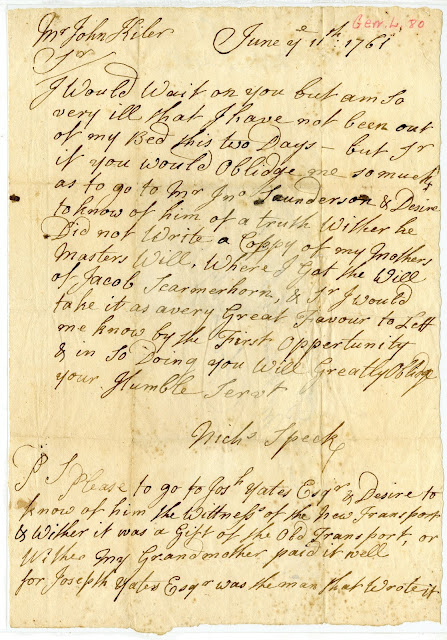A researcher recently wrote to our library seeking information about the Speck family of Schenectady. We had come across the name before, as it is the surname of one of the earliest known free African-American families in our area. The Speck (or Spack) surname appears in the early records of the First Reformed Church and in colonial-era tax lists. Also, the house at 116 Front Street bears a plaque indicating it as the Symon Speck House. Encouraged by having come across the name before, I began conducting research to connect members of the family with each other.
The earliest reference I found to the family in Schenectady was the 1705 baptism of Abraham, the son of Symon, a slave of Captain Sanders, and Susanna Tomassen. According to the records of the First Reformed Church, the couple had several other children over the years. The Speck surname first surfaced in 1723 with the baptism of another of the couple's children. Researcher Susan Staffa believes that Nicholas Speck, son of Simon, was the caretaker for the cemetery of the First Reformed Church, which was then west of the intersection of Front and Ferry Streets. Speck's grandmother, Catrina Ezabel, a freewoman, had purchased the land from the First Reformed Church around 1725. It is speculated that the house now known as the Symon Speck House was built there and later moved and adjoined to the house at 114 Front Street, where both structures still stand today. Generations of the Speck family stayed in the area and married into the Cesar/Seaser, Thomas/Thomson, and Primus families. Specks remained in Schenectady until about 1820, when the name disappeared from records.
Connecting people to the Speck name sometimes proved to be a bit of a challenge. When I began the research, I assumed that it would be easy to distinguish enslaved and free African-Americans in the records; I thought that free people would carry surnames and that enslaved people would either not carry a surname in the records, or they would carry the surname of a slaveowner. This was sometimes true, but many times was not. Even when a person was identified as a “free negro,” the person’s surname might be omitted from a record. For example, one baptismal record from the First Reformed Church in Schenectady, which usually records the father's surname and the mother's maiden name, shows the parents of a child as Jupiter (no last name) and Elizabeth Speck. In another record, a baptismal record shows the parents of a child as Jupiter Primis and Elizabeth (no last name).
I first searched through transcribed church records using the surname index, as I normally do. I found some results, but when I consulted the transcribed records I noticed several entries for which no last names were listed. Some indexes for church records do not include entries for people for whom no last name is provided. I found that even in indexes that incorporated people without surnames (either under "no surname" or "Negro"), many such entries were missed. I discovered several entries in baptismal records by scanning through all of the baptisms for a particular time period. As I scanned the pages, I was not only able to find several entries for people who appeared to be part of the Speck family, but other families of Schenectady's African-American community, both enslaved and free, began to come into view. Although this is quite a tedious method of searching for information, I found it very helpful in finding members of the family who might have otherwise been missed. Also of great help were the births recorded by midwife Mary Stevens from 1767 to 1788, which were transcribed and published with the records of St. George's Church.


No comments:
Post a Comment